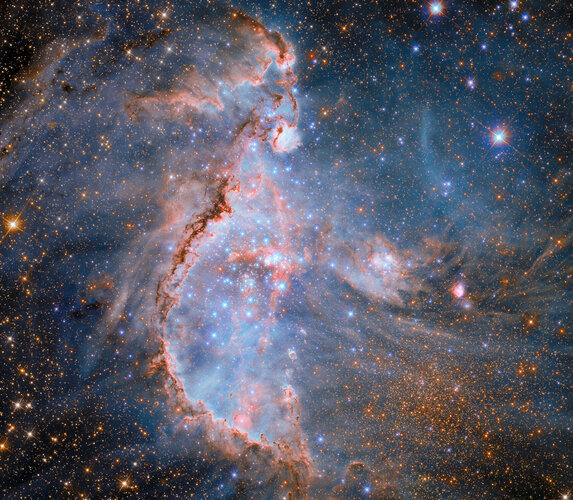
Copernical Team
Sateliot secures major backing to scale 5G IoT satellite network
 Sateliot has finalized a euro 70 million Series B funding round, reinforcing its role as the first 5G IoT mobile operator delivering connectivity from space. The company uses an innovative low-Earth orbit (LEO) satellite constellation to provide cost-effective global Internet of Things (IoT) services, enabling coverage where traditional networks fall short.
The newly raised capital will a
Sateliot has finalized a euro 70 million Series B funding round, reinforcing its role as the first 5G IoT mobile operator delivering connectivity from space. The company uses an innovative low-Earth orbit (LEO) satellite constellation to provide cost-effective global Internet of Things (IoT) services, enabling coverage where traditional networks fall short.
The newly raised capital will a How to engineer microbes to enable us to live on Mars
 Associate Tutor and PhD Candidate in Philosophy of Science, Manchester Metropolitan University
A field known as synthetic biology has become one of the most highly anticipated in science. Its outputs range from golden rice, which is genetically engineered to provide vitamin A, to advances stemming from the Human Genome Project, which successfully mapped the entire human genome. Prominent v
Associate Tutor and PhD Candidate in Philosophy of Science, Manchester Metropolitan University
A field known as synthetic biology has become one of the most highly anticipated in science. Its outputs range from golden rice, which is genetically engineered to provide vitamin A, to advances stemming from the Human Genome Project, which successfully mapped the entire human genome. Prominent v Eutelsat expands airborne internet with operational LEO service for aircraft
 Eutelsat has officially launched its OneWeb-powered low Earth orbit (LEO) connectivity services for both commercial and private aircraft, with over 100 certified antennas now installed and the first aircraft already flying with active LEO internet connections.
In addition to its longstanding geostationary (GEO) satellite offerings, Eutelsat is delivering a hybrid multi-orbit model to the a
Eutelsat has officially launched its OneWeb-powered low Earth orbit (LEO) connectivity services for both commercial and private aircraft, with over 100 certified antennas now installed and the first aircraft already flying with active LEO internet connections.
In addition to its longstanding geostationary (GEO) satellite offerings, Eutelsat is delivering a hybrid multi-orbit model to the a Amazon prepares to launch first full batch of Project Kuiper satellites
 Amazon's Project Kuiper said Wednesday it is planning to launch 27 satellites April 9 from Cape Canaveral Space Force Station, Florida.
It is the project's first full batch of Internet connection satellites and will be launched by United Launch Alliance.
According to Project Kuiper their first-generation satellite system will put a total of 3,200 into orbit in the first constella
Amazon's Project Kuiper said Wednesday it is planning to launch 27 satellites April 9 from Cape Canaveral Space Force Station, Florida.
It is the project's first full batch of Internet connection satellites and will be launched by United Launch Alliance.
According to Project Kuiper their first-generation satellite system will put a total of 3,200 into orbit in the first constella Rising odds asteroid that briefly threatened Earth will hit Moon
 An huge asteroid that was briefly feared to strike Earth now has a nearly four percent chance of smashing into the Moon, according to new data from the James Webb Space Telescope.
The asteroid, thought to be capable of levelling a city, set a new record in February for having the highest chance - 3.1 percent - of hitting our home planet than scientists have ever measured.
Earth's plan
An huge asteroid that was briefly feared to strike Earth now has a nearly four percent chance of smashing into the Moon, according to new data from the James Webb Space Telescope.
The asteroid, thought to be capable of levelling a city, set a new record in February for having the highest chance - 3.1 percent - of hitting our home planet than scientists have ever measured.
Earth's plan Earth from Space: The shrinking Aral Sea
 Image:
The Copernicus Sentinel-2 mission shows us what is left of the Aral Sea, once the fourth largest lake in the world.
Image:
The Copernicus Sentinel-2 mission shows us what is left of the Aral Sea, once the fourth largest lake in the world. Hubble spots stellar sculptors at work in a nearby galaxy
 Image:
Image:
This new image from the NASA/ESA Hubble Space Telescope showcases NGC 346, a dazzling young star cluster in the Small Magellanic Cloud. The Small Magellanic Cloud is a satellite galaxy of the Milky Way, located 210 000 light-years away in the constellation Tucana. The Small Magellanic Cloud is less rich in elements heavier than helium — what astronomers call metals — than the Milky Way. This makes conditions in the galaxy similar to what existed in the early Universe.
Although several images of NGC 346 have been released previously, this view includes new data and is the first to combine
A chance alignment in Lupus
 Image:
A chance alignment in Lupus
Image:
A chance alignment in Lupus Earth Observation Excellence Award 2025 winners

In recognition of outstanding contributions to scientific advancement and innovation using Earth observation data, the ESA Earth Observation Excellence Award is presented annually to early-career researchers.
Firing up HENON’s engine
 Image:
Firing up HENON’s engine
Image:
Firing up HENON’s engine 